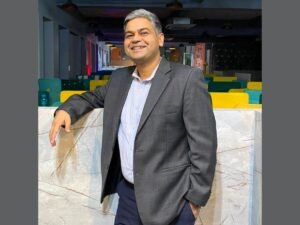A Study of the Hurdles Faced by Persons with Disabilities in the Indian Workforce – PNN Digital

Chandra Shekhar Singh, Director, Posterity Consulting
New Delhi (India), January 1: In India’s societal tapestry, the portrayal of disability is evolving, yet a myriad of hurdles persist, painting a complex picture of inclusion and disparity. Census data from 2011 unveiled a staggering count of 2.68 crore or 2.1% (56% males & 44% females) individuals grapple with disabilities. To give an illustration, the numbers are congruent to entire population of countries like Australia, Nepal etc. This demographic amalgamates various disabilities. Yet, deeper within these figures lie pressing issues. Health, employment, education, and living standards loom large as defining indicators shaping the narrative of exclusion, exacerbated by enduring social stigmas. This burden extends beyond the physical, leading to the isolation and unfortunate rejection of individuals.
Surely, India’s journey towards inclusive policies has indeed seen progress. From ratifying international conventions like the UNCRPD to enacting the Rights of Persons with Disabilities Act, 2016, and Article 41 of the Indian Constitution granting rights to work, education, and public assistance, significant legislative strides have been taken. In 2018, the Department of Personnel & Training (DoPT) issued a circular specifying 4% reservation for persons with benchmark disabilities in Government jobs, under Section 34 of the RPwD Act, 2016.
Yet, genuine transformation hinges on the allocation of resources for effective implementation. Fiscal support remains limited, with meagre budgetary allocations to vital sectors like health, education, and welfare. In FY 2023–24, the Department of Empowerment and Welfare of Persons with Disabilities (DEPwD) under the Ministry of Social Justice and Empowerment (MSJE) received only INR 1,225 crore, amounting to a mere 0.027 percent of the total budget.
For persons with disabilities, barriers to access span various sectors, yet, only three central ministries (MoRD, MoHFW and MSJE) have dedicated budgetary allocations for persons with disabilities and the disability-specific allocation constitutes a relatively negligible portion of these ministries’ budgets. The SIPDA, an umbrella scheme for safeguarding PwD rights has seen its budget nosedive from INR 315 Cr (FY 2019–20) to only INR 150 crore (FY 2023–24). Despite legislative safeguards, their employment remains an unmet need, with a mere fraction finding opportunities in the industrial domain. According to NCPED, of the some 70 million persons with disabilities in India, only about 100,000 have succeeded in obtaining employment in industry.
As per the 2011 Census:
- about 36% of persons with disabilities are working, with 31% constituting agricultural laborers, revealing the diverse occupational landscape they engage in.
- Among them, 47% of males and only 23% of females with disabilities are employed.
- Compared to 25% of rural females, only 16% of urban females with disabilities are part of the workforce.
- The numbers are same for males in both rural an urban setup
In the private sector, as per the latest annual disclosure data by Nifty 50, among top Indian companies only 3 persons with disability out of every 1,000 employees are on their rolls, and only five companies have above 1% PwD employees. Notably, 4 of these are public sector companies (SBI leading the list followed by BP, ONGC, PGC) that are required by law to reserve 4% of all jobs for disabled people. The lone private company that reached even 1% is Titan.
The data provides interesting insights about gender disparity in workforce. While males are at same employment rate in urban and rural setup, females are at disadvantage in urban setup. This provides important insights on how government programs and corporate initiatives are not being as effective as they should given there are equal opportunities being available for women. With so many NGOs working in urban setup for women and PwD, these numbers tell a different story. Which leads you to think, are these organizations fulfilling their agendas and what are possible potholes for them in achieving their agenda/
One insight was reported by Economic Times by a former director HR at NTPC who told the publication that there were legacy issues that were hampering the public sector companies. He highlighted nature of jobs also plays a role, with banking and IT sectors exhibiting higher ease in PwD hiring compared to on-field roles. Yet, neither of those sectors have substantial numbers to prove this claim.

Arguments are also made that literacy is an issue for employment. Let’s take a closer look at numbers from NFHS-5 data:
- 55% of person with disability in India are literate.
- 49% of all people with locomotor disability have higher education. A huge disparity coexists with all other disability; meager 19% mental and 11% visual and speech related person with disability have higher education.
- Kerala and Goa having the highest rates of literacy and Arunachal Pradesh and Rajasthan have the lowest. Ironically lowest rate of employment of person with disability are in Lakshadweep, followed by Kerala and Delhi.
- Among the State / UTs, Nagaland, Sikkim and Arunachal Pradesh have highest rates of workers with disability.
The data clearly provides a juxtaposition between education numbers and employment rates. Even with 49% of higher education, our industries across all sectors are massively failing to train and employ talent thereby losing out on talent.
The observation of job postings for PwD hiring on various boards not translating into substantial hires raises pertinent questions. Is this a skill gap, or are these postings misleading? While many companies claim to be inclusive, we often see that a majority of times, the same small percentage of “diversity/ PwD” individuals get passed around from company to company and not much of the new talent is on-boarded in the job market. The corporate setup in India is doing too little, too less for all the PR that is generated annually by them in the name of PwD hiring.
One way India can really work around these barriers is by setting up training centres where companies can train persons with disabilities to be eventually absorbed into their systems. Infact, it can be one of the most sustainable CSR initiatives for companies where they can train new talent tailored to their specific needs and fulfil their social responsibility. There is a need to develop platforms where PwD can be integrated, upskilled and absorbed into organized setup. Companies need to develop alternate criteria and interview processes to empower and truly engage and absorb people with disability in mainstream workforce. Organizations need to find alternate benchmarks while hiring PwD. Benchmarking normative workforce and expecting same from PwD is not only against the concept of equity but also a hurdle in being truly engaging given the opportunities to grow and learn are limited for people with disability in our society.
However, amidst these challenges, rays of hope are emerging. The Government’s PM DAKSH-DEPwD portal, recently launched, stands as a beacon—a digital haven facilitating job access for persons with disabilities across the nation. With plans to add 25 lakh jobs, this initiative holds promise in potentially transforming the landscape of employment for this marginalized section of society.
In today’s era, where societal integration stands pivotal for sustainable development, persons with disabilities represent a substantial percent of India’s populace. As India grapples with reconciling its aspirations for an inclusive society with the ground realities faced by millions living with disabilities, they yearn not merely for opportunities but for dignity, recognition, and an equitable shot at a better life.
Written by – Chandra Shekhar Singh, Director, Posterity Consulting
(Assisted by – Swati Aggarwal)
If you have any objection to this press release content, kindly contact pr.error.rectification@gmail.com to notify us. We will respond and rectify the situation in the next 24 hours.

Atul Tiwari is a seasoned journalist at Mumbai Times, specializing in city news, culture, and human-interest stories. With a knack for uncovering compelling narratives, Atul brings Mumbai’s vibrant spirit to life through his writing.





